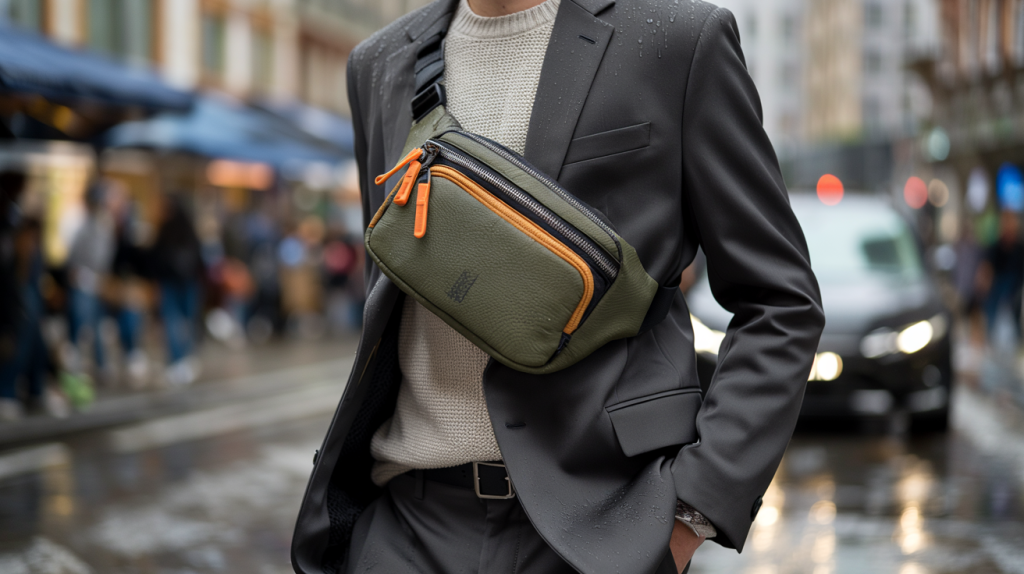Sac Banane Tendance 2026 : What Leads the Belt Bag Wave
The sac banane is not a throwback for 2026. It shifts into a refined, crossbody‑first silhouette, built for phones, travel checks and city sprinting. Think recycled nylon that resists rain, bio‑based leather for polish, padded straps that sit comfortably all day. The trend points to modular add‑ons, smarter security and a low‑key logo look that plays well with tailoring and sneakers.
There is momentum behind it. The Business of Fashion and McKinsey’s “State of Fashion 2024” projected global fashion growth of 2 to 4 percent in 2024, favoring resilient, wearable categories. Lyst’s Year in Fashion 2023 put a compact, hands‑free bag at the top – the Uniqlo Round Mini Shoulder Bag – a sign of the appetite for small, functional carriers. Add travel rules pushing compact items – Ryanair’s personal item cap sits at 40 x 20 x 25 cm – and the case for a belt bag in 2026 becomes obvious.
Runway to Street : Designers, Data and Why the Fanny Pack Returns
The main idea is simple: pockets did not keep up with our lives. Bigger phones, transit cards, earbuds, charger, keys – a sac banane clears the hands while keeping essentials close. After the streetwear boom of the late 2010s, luxury and sports labels kept refining the format. Nike x Jacquemus in 2022 made the sling‑style belt bag feel luxe‑sport all at once, and runway coverage on Vogue Runway through 2024 showed utility straps and mini baggage popping up across big houses.
Numbers add context. The Business of Fashion and McKinsey flagged steady, not breakneck, growth for 2024 at 2 to 4 percent – categories that blend utility and style tend to benefit in such cycles. Stadium and travel constraints nudge behavior too. With airlines like Ryanair fixing tight personal item sizes, compact crossbody or waist carry gets the green light for city breaks and quick hops.
One more reason: perennial virality. Lululemon’s Everywhere Belt Bag surged across TikTok in 2022, normalizing the look off the trail and into daily commutes. That cross‑over matters for 2026 because it anchors a cleaner, more adult version – less touristy, more tailored – without losing the ease people already trust.
How to Choose a 2026‑Ready Sac Banane : Materials, Size, Security
Shoppers often chase the logo and miss the fit. A sac banane works only if the strap length hits right across the chest or waist without digging in, and the body sits flat under a coat. Recycled nylon or regenerated polyamide handles rain and daily knocks, while bio‑based or chrome‑free leather trims lift the look for office hours.
Security features keep trending up. Hidden back pocket for passport, lockable zipper pulls, RFID lining on at least one compartment – these details read discreet, not techy. For travel, one exterior phone sleeve helps at gates, with the main pocket zipped and pointed inward. That reduces the classic pickpocket risk by a lot.
Brands publish specs – use them. If a bag’s volume sits around 1.5 to 3 liters, it usually fits a large phone, small wallet, keys, sanitizer, earbuds. Anything bigger starts to look bulky under a blazer. Water resistance rated to a shower‑proof standard helps for daily storms; taped seams are a bonus in real life downpours.
Before checkout, run this quick list:
- Shape : slim sling that wears crossbody and at the waist without bulging.
- Material : recycled nylon or bio‑based leather, with wipe‑clean lining.
- Security : inward‑facing zipper, hidden back pocket, optional RFID sleeve.
- Strap : wide, padded, with a low‑profile buckle and enough adjustability for coats.
- Capacity : roughly 1.5 to 3 L so a big phone, keys and wallet sit flat.
- Weather : water‑repellent shell and at least partially taped seams.
- Modularity : small clip points for AirTag holder or sunglasses loop.
Style Playbook 2026 : Ways to Wear the Belt Bag All Year
Spring says color. Expect earthy olives, stone, ink navy, then one sharp accent – mandarin or cobalt – to break monochrome fits. Worn high across the chest with a tee or light knit, the bag becomes a graphic line more than a bulky pouch. That’s the shift for 2026: cleaner geometry.
Summer leans technical. A ripstop sling in recycled fibers pairs with lightweight shorts and trail‑ish sneakers for weekend markets, then slips under a linen overshirt for dinner. Cities with bag rules for venues applaud transparent or mesh panels; stadium‑ready variants already exist, and they look better when trims stay matte.
Autumn asks for texture. A pebble‑grain leather belt bag under a trench replaces a crossbody tote, freeing hands for a coffee and umbrella. Minimal branding wins here. For winter, go padded. Quilted nylon with insulated backing sits comfortably over heavier wool. Wear it slightly higher on the torso so coats do not bunch.
The missing piece many skip is modularity. A tiny clip‑on pouch for coins or keys, a detachable strap that swaps from sport webbing to leather, a slip for a tracker – these extend the bag across settings without buying two. That is definetly the 2026 twist: one sac banane, multiple roles, grounded in the real constraints people face when they commute, fly or just walk the dog.
